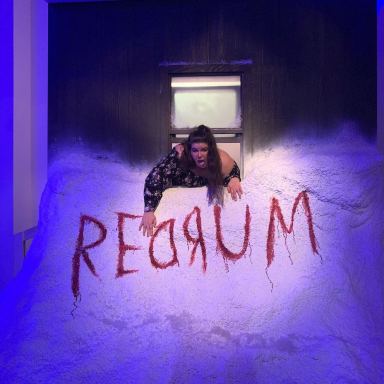60 Fun Facts and Lore About ‘The Shining’ and ‘Doctor Sleep’
“If you can be frightened by a ghost story, then you must accept the possibility that supernatural beings exist.”
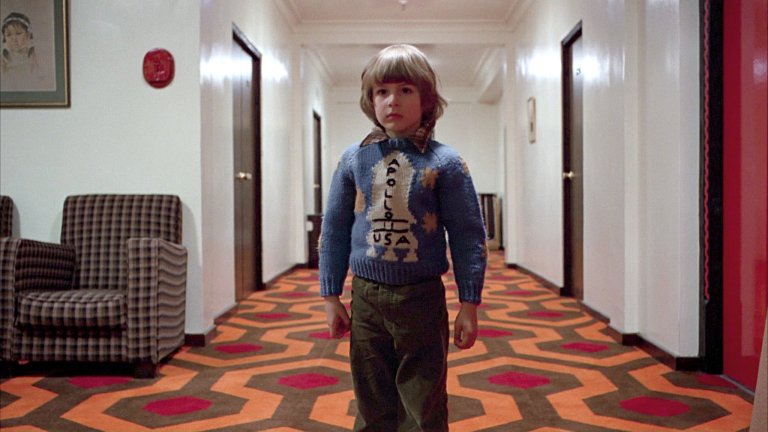
The horror world was forever changed by a last-minute one-night vacation that writers Stephen and Tabitha King decided to take in October 1974. The couple had been living in Boulder, Colorado for a year so Stephen could get some inspiration for his next novel, which he wanted to set somewhere other than Maine as both of the books he’d released so far, Carrie and ‘Salem’s Lot, were set in his home state. The day before Halloween the couple decided to take a weekend trip up into the Rocky Mountains. They landed at the Stanley Hotel in Estes Park, which was getting ready to close for the winter. That night, Stephen and Tabitha were the only guests at the hotel.
That evening Stephen and Tabitha ate dinner alone in the hotel’s grand ballroom surrounded by other tables with the chairs up as staff had already cleaned the room for the end of the season. Taped orchestral music played and they ate the only meal still available on the menu. The situation reminded Stephen King of an unfinished story he’d started a few years earlier which he called Darkshine about a boy with psychic powers who was stuck in a psychic amusement park. Of that evening, Stephen has said “I mean, it was like God had put me there to hear that and see those things.”
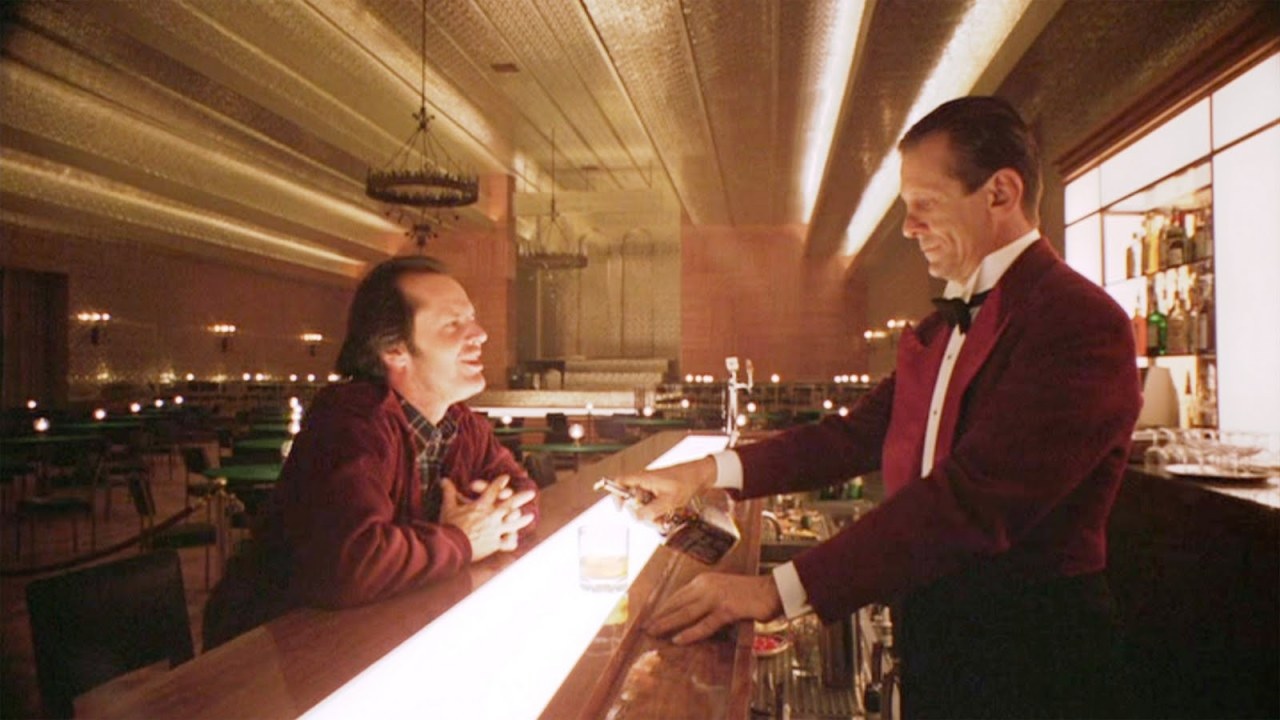
As Tabitha retired, Stephen walked the deserted halls and had a drink at the bar as the only guest, served by a bartender named Grady. When he went to sleep, he had a terrifying nightmare his three-year-old son was being chased through the hotel by a firehose come to life. He put his nightmare together with the image of his psychic boy from Darkshine wandering those long, empty corridors of the hotel and the story finally clicked. King says, “I woke up with a tremendous jerk, sweating all over, within an inch of falling out of bed. I got up, lit a cigarette, sat in a chair looking out the window at the Rockies, and by the time the cigarette was done, I had the bones of the book firmly set in my mind.”
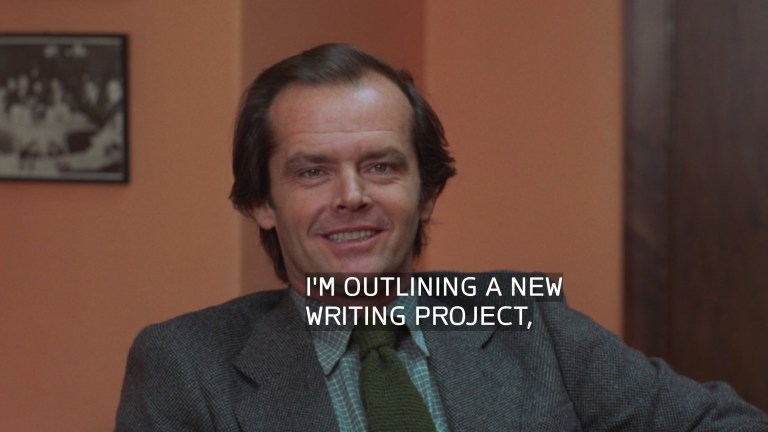
While writing, Stephen drew on his own experiences as a man with demons of his own — the central character of Jack Torrance is also a struggling writer who recently relocated to Boulder and had a wife and child to provide for. Like Jack, Stephen King had an unhealthy relationship with alcohol, anger, and shame. He was aware that his wife and children sometimes paid the price for his vices:
Sometimes you confess. You always hide what you’re confessing to. That’s one of the reasons why you make up the story. When I wrote The Shining, for instance, the protagonist of The Shining is a man who has broken his son’s arm, who has a history of child beating, who is beaten himself. And as a young father with two children, I was horrified by my occasional feelings of real antagonism toward my children. Won’t you ever stop? Won’t you ever go to bed? And time has given me the idea that probably there are a lot of young fathers and young mothers both who feel very angry, who have angry feelings toward their children. But as somebody who has been raised with the idea that father knows best and Ward Cleaver on Leave It to Beaver, and all this stuff, I would think to myself, Oh, if he doesn’t shut up, if he doesn’t shut up… So when I wrote this book I wrote a lot of that down and tried to get it out of my system, but it was also a confession. Yes, there are times when I felt very angry toward my children and have even felt as though I could hurt them. Well, my kids are older now. Naomi is fifteen and Joey is thirteen and Owen is eight, and they’re all super kids, and I don’t think I’ve laid a hand on one of my kids in probably seven years, but there was a time…
Stephen King as quoted by The Stephen King Companion
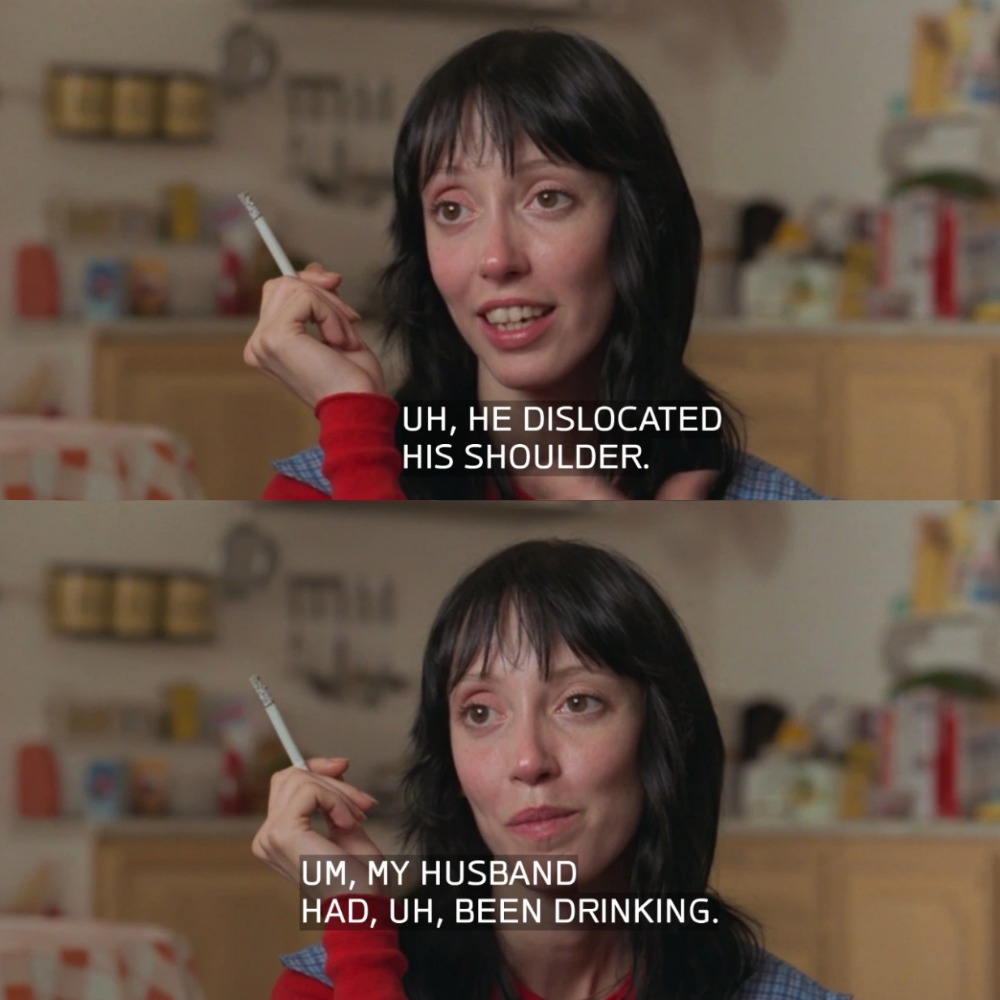
King wrote The Shining in only four months and it became his first hardback bestseller. The story (and King) catapulted into even greater fame when Stanley Kubrick adapted it into his 1980 film. Incredibly, three decades later Stephen King sat down and wrote a sequel titled Doctor Sleep. The novel followed Danny Torrance after the events at The Overlook hotel as he grew into a man just like his father — an alcoholic driven by the fear of facing his core shame. Read on for the colorful and creepy history of The Shining and Doctor Sleep and their adaptations into film:
Trivia facts about The Shining (1974 novel)
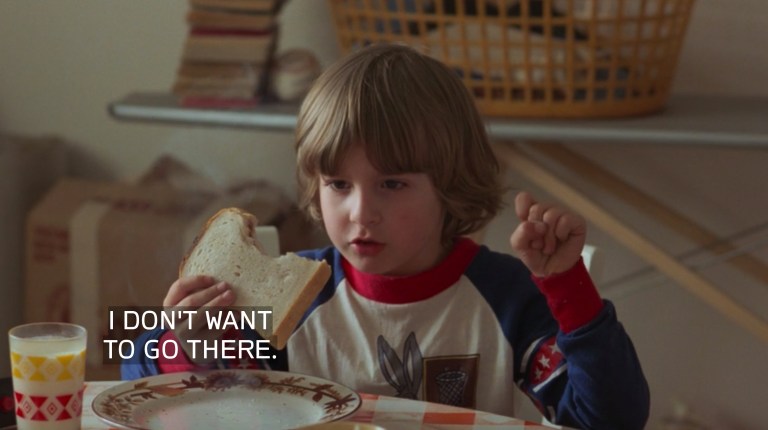
- The title of The Shining comes from the John Lennon song “Instant Karma!” in which he sings “We all shine on.”
2. The Overlook Hotel is fictional. Stephen King used The Stanley hotel in Estes Park, Colorado as the inspiration for The Overlook. Like The Overlook, The Stanley is in the Rocky Mountains of Colorado and has a storied history both as a grand hotel that attracted celebrities such as Harry Houdini, John Phillip Sousa, and The Unsinkable Molly Brown, and as a haunted hotel with various overlapping stories of the paranormal guests mingling with the human guests. One of the most famous stories in The Stanley’s lore is that Jim Carrey fled Room 217 (the same room where the Kings stayed) in the middle of the night while filming Dumb and Dumber (1994) at the hotel. He has never publicly spoken about what drove him out of the hotel at such an hour.
3. The Stanley Hotel opened on the Fourth of July in 1909. It was built in colonial revival style by Freelan Oscar Stanley, who invented the Stanley Steamer. Every year until 1983 it closed for the winter. Now, if you venture up there at the end of October, you’d likely find the hotel packed with guests attending a Shining-inspired Halloween party.
4. In 1911 a leaking gas light outside of guest room 217 caused an explosion that severely injured a maid working for the hotel. This room is said to still be haunted by the maid and for over 100 years staff and guests have had paranormal experiences in this room.
5. Room 217 is where Stephen and Tabitha King stayed, but at the request of Oregon’s Timberline Lodge (used for exterior shots of The Overlook), the room number is changed to 237 in Stanley Kubrick’s film. Contrary to the Timberline’s thought process, “Room 237” is now their most requested room, an example of The Streisand Effect. Room 217 at The Stanley now contains a writing desk and photo of Stephen King to memorialize his night at the hotel.

6. King’s publisher tried to talk him out of publishing The Shining because it would be his third horror novel and he would get typecast as a horror writer. As he had been reading, writing, and trying to publish horror stories since he was a schoolboy, King considered it a compliment and went ahead with publication.
7. The novel also explains that Danny was born with a caul, a harmless thin membrane that covers a newborn’s face in 1 in 80,000 births. It is an auspicious omen some believe means the child will grow up to have psychic abilities.
8. Some of King’s literary inspirations for The Shining include:
- The Ray Bradbury short story “The Veldt,” about a nuclear family living in a home with a mind of its own. Wendy may be named after the “Wendy” in this story.
- Shirley Jackson’s 1959 novel The Haunting of Hill House about a haunted house that seems to be sentient. Mike Flanagan, who directed an adaptation of The Haunting of Hill House for Netflix, also directed the film adaptation of Doctor Sleep.
- Edgar Allan Poe’s suspenseful short stories “The Fall of the House of Usher” and “The Masque of the Red Death.”
- Robert Marasco’s novel Burnt Offerings.
- Guy de Maupassant’s short story “The Inn.”
Trivia facts about The Shining (1980) dir. Stanley Kubrick

9. Around 1975 Stanley Kubrick set out to make a horror film that was as commercially successful as it was artistic. He and his assistants looked at dozens of horror novels until Kubrick became enamored with The Shining, which was not even in print yet.
10. Stephen King wrote a script, which Kubrick rejected. Kubrick hired writer Diane Johnson, who was literally a doctor of gothic studies, and they adapted the novel into a movie script based on Kubrick’s vision, which was not a literal interpretation of King’s novel. Johnson looked down on Stephen King’s success, saying, “The Shining is not part of great literature. It is scary, it is effective and it works…but it is also true that one has less scruples when destroying it: One is aware that a great work of art is not being destroyed.”
11. Diane Johnson suggested to Kubrick that the character of Danny Torrance die!
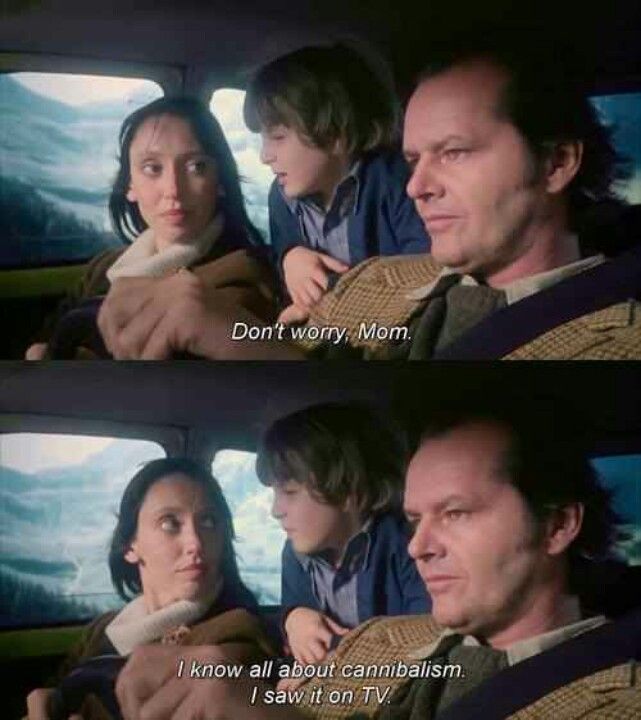
12. Kubrick had a screening of David Lynch’s Eraserhead (1977) for cast and crew so that they could see the tone he hoped to create with The Shining.
I think the unconscious appeal of a ghost story, for instance, lies in its promise of immortality. If you can be frightened by a ghost story, then you must accept the possibility that supernatural beings exist. If they do, then there is more than just oblivion waiting beyond the grave.
Stanley Kubrick, interview with Michel Ciment
13. Much of the film was shot on a soundstage in London. The interior set design of The Overlook was based on the Ahwahnee Hotel in Yosemite National Park. The Timberline Lodge in Oregon was used for the exterior of the hotel.
14. Using a soundstage gave Kubrick the ability to build a nonsensical floor plan for The Overlook. The audience follows the steadicam through a maze of a hotel that could not exist in real life. For instance, there is no way that Mr. Ullman could have a window in his office.
15. Part of the soundstage burned down during filming because of the intense lighting. Despite the frozen winter aesthetic, filming was incredibly hot for cast and crew as there was no air conditioning on the soundstage.
16. The Steadicam was a newly developed technology that allowed cameras to go almost anywhere without the shaking or unsteadiness that usually accompanied shots in places where a dolly was impractical. The Shining, along with a handful of other films such as Halloween (1978) (which actually used a Panaglide to create the same kind of tracking shots as a Steadicam), popularized use of the Steadicam.
17. Steadicam inventor Garrett Brown worked on production with Kubrick. He achieved the iconic shots that follow Danny on his big wheel by riding in a wheelchair with the Steadicam fixed to it. Grips moved the wheelchair while Garrett operated the camera.
18. Differences between Kubrick’s movie and King’s novel:
- King’s biggest problem with Kubrick’s film is that he feels Kubrick and Jack Nicholson portray Jack Torrance as already crazy. King’s protagonist is a normal man who is driven to the edge by the haunted hotel, his inner demons, and cabin fever.
- King also disliked how Wendy was portrayed in the film as being submissive and weak. In the novel, Wendy Torrance is intelligent and adept. Kubrick said he thought the audience wouldn’t buy that a woman like that was “stuck” with Jack.
- In the movie, Mr. Ullman is happy to hire Jack. In the novel, Mr. Ullman reveals that he does not wish to hire him but is doing so because Jack’s drinking buddy, Al Shockley, is on the board and asked Ullman to hire him for the position.
- King wrote about Danny’s experience with a haunted children’s playground and hedge animals that chased him. This was considered impossible to do with special effects at the time, and the hedge maze was created instead. The Stanley Hotel now has a hedge maze in honor of the movie.
- Inside the hotel, Danny was terrorized by a sinister-looking fire hose. This magic of Stephen King’s writing seems impossible to transfer into film without it ending up being unintentionally funny. (A malevolent fire hose may have ended up being one of the goofiest horror villains of all time.) Instead, the ghost girls and the bloody elevator shots were used to portray the horror that was haunting The Overlook.
- There is more focus in the book on the hotel as a malevolent entity. In the boiler room, Jack Torrance finds newspapers accounting for the macabre history of the hotel and even threatens the manager, Stuart Ullman, that he is considering writing a tell-all of the hotel’s infamous and unexplored history. The fact that he finds the newspapers and then is “unblocked” was compelling to Kubrick’s co-writer Diane Johnson, and she did write this scene in the adaptation, but Kubrick edited it out of the final script.
- Instead, Kubrick portrayed Jack’s writer’s block as continuing with the “All work and no play makes Jack a dull boy” typewriter scene, which was not part of the book at all. A scrapbook of the hotel’s history can be seen next to Jack’s typewriter, but it is never mentioned in the film.
- Jack playing with the yellow tennis ball only happens in the film.
- Kubrick called King’s ending “a bit hackneyed to me and not very interesting.”
- In the movie, Wendy and Danny are closer; in the novel Danny and Jack are closer. The novel ends with Danny successfully getting through to his father. Jack Torrance sacrifices himself by helping Wendy and Danny escape the hotel, sacrificing himself to an exploding boiler in the process. No such reconnection occurs in the film, and the boiler is only mentioned once in the entire movie.
Not that religion has to be involved in horror, but a visceral skeptic such as Kubrick just couldn’t grasp the sheer inhuman evil of the Overlook Hotel. So he looked, instead, for evil in the characters and made the film into a domestic tragedy with only vaguely supernatural overtones. That was the basic flaw: because he couldn’t believe, he couldn’t make the film believable to others. What’s basically wrong with Kubrick’s version of The Shining is that it’s a film by a man who thinks too much and feels too little; and that’s why, for all its virtuoso effects, it never gets you by the throat and hangs on the way real horror should.
Stephen King, Danse Macabre
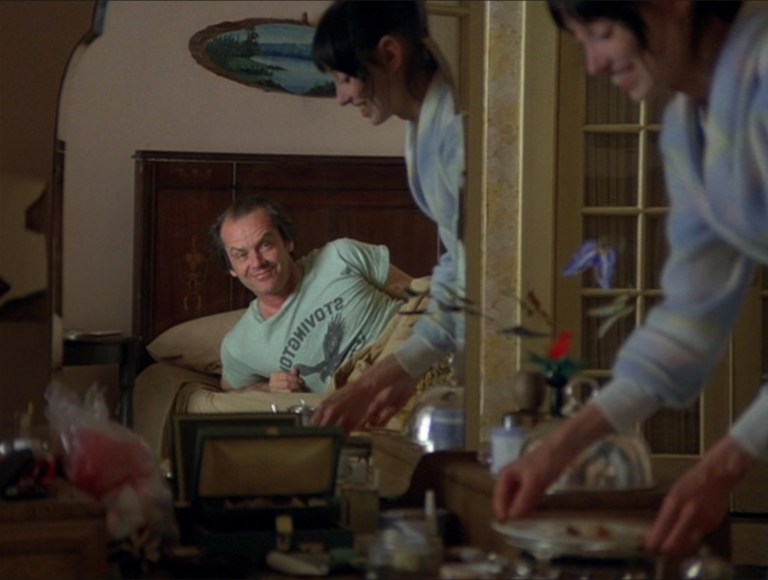
19. It’s not mentioned directly in Kubrick’s film, but the reason Jack and Wendy relocated to Boulder, and the reason Jack is desperate for the caretaker job (though he pretends not to be) is that he was fired from his job as a teacher at a New England prep school, Stovington, for slashing the tires of a student in a fit of anger. The school is also where Jack met Al Shockley, a fellow alcoholic who got him the job as the Overlook’s caretaker.
20. Kubrick’s other choices for the role of Jack Torrance include Robert De Niro, Robin Williams, and Harrison Ford. Stephen King suggested Michael Moriarty, Jon Voight, or Martin Sheen but was rejected.
21. Jack Nicholson suggested Jessica Lange for the role of Wendy.
22. Scatman Crothers was cast because Kubrick’s first choice for Halloran, Slim Pickens, refused to work with the director again after having to work with the notoriously perfectionistic director while making Dr. Strangelove or: How I Learned to Stop Worrying and Love the Bomb (1964).
23. After working with Kubrick, Crothers’s next film was directed by Clint Eastwood, a director famous for the opposite reason as Kubrick: He generally liked to do only one take of a scene if he could get away with it. Scatman cried on set when he realized he would no longer have to do take after take with an unrelenting perfectionist as his boss.
24. Danny Lloyd was cast as Danny Torrance and was told he was making a drama, not a horror movie.
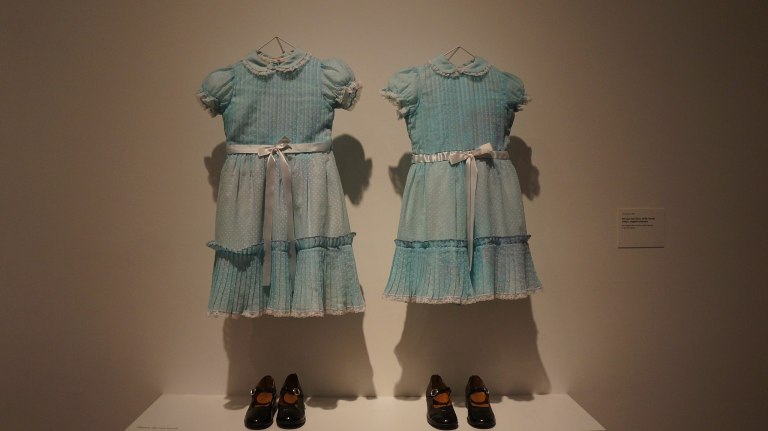
25. Lisa and Louise Burns are identical twins known colloquially as the “Grady Twins” from The Shining. However, in both the book and the film script the girls are not twins, merely sisters.
26. Despite having studied under photographer Diane Arbus, Stanley Kubrick says the Grady Twins’ resemblance to her famous “Identical Twins, Roselle, New Jersey, 1967” photograph was unintentional. Arbus’s Twins photo is also a plot point in the crime thriller A Simple Favor by Darcey Bell.
27. Jack Nicholson used to be a volunteer firefighter, so when he breaks down the door with an axe, he demolished the prop door too easily and a real door was used instead.
28. One of the most famous lines in horror, “Heeeere’s Johnny!,” was ad-libbed by Jack Nicholson. Because Stanley Kubrick primarily lived in England and was unfamiliar with its reference, The Tonight Show Starring Johnny Carson, he almost cut it.
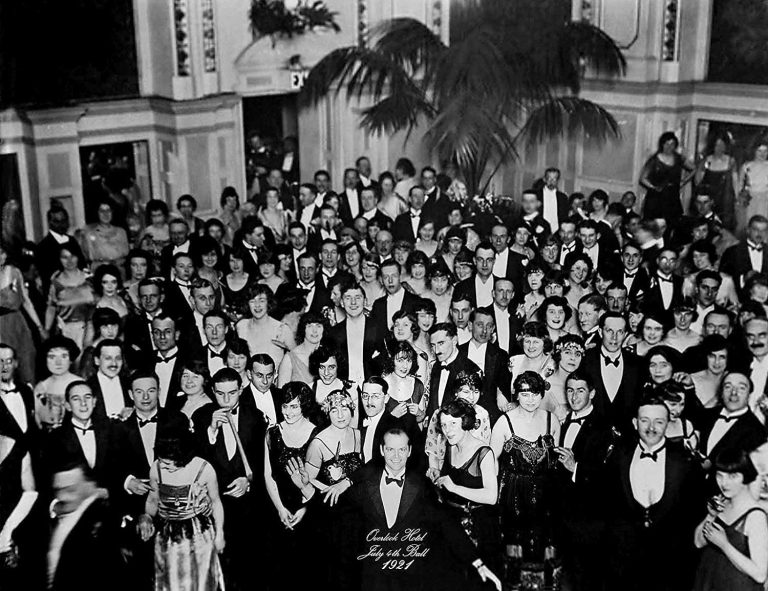
29. When Mr. Ullman tells Jack about the old caretaker who killed his family, his name is Charles Grady. The man Jack “meets” in the red bathroom says his name is Delbert Grady. Writer Gordon Dahlquist argues that this is connected to the final scene where we see Jack in the photo of the July 4th ball: “The duality of Delbert/Charles Grady deliberately mirrors Jack Torrance being both the husband of Wendy/father of Danny and the mysterious man in the July 4th photo. It is to say he is two people: the man with choice in a perilous situation and the man who has ‘always’ been at the Overlook.” Other versions of this “duality” are present all over Kubrick’s film. Another example is the “two women” in room 237. This theme is again explored in Doctor Sleep when Jack is seen as The Overlook’s bartender.
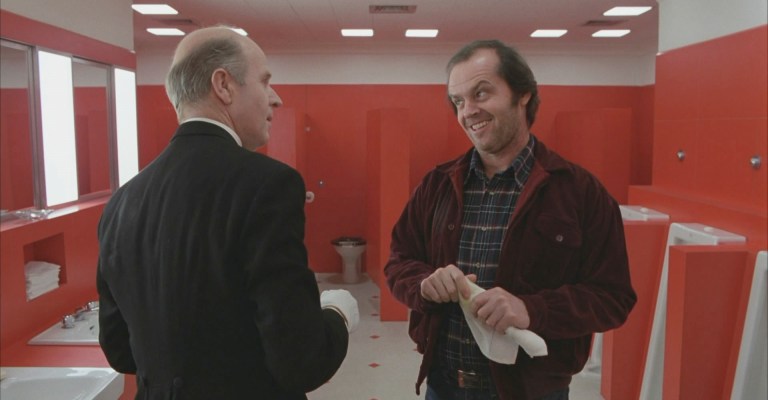
30. Kubrick also breaks a cardinal rule of filmmaking in this scene by “crossing the line” and moving the camera so much that Jack and Delbert Grady end up changing positions from the beginning of the scene. This is meant to show that the two are becoming more similar and interchangeable.
31. The “red bathroom” aesthetic was inspired by a real hotel bathroom at the Biltmore Hotel in Arizona designed by Frank Lloyd Wright.
32. The Shining was the last role for both actresses who portrayed the woman in room 237.
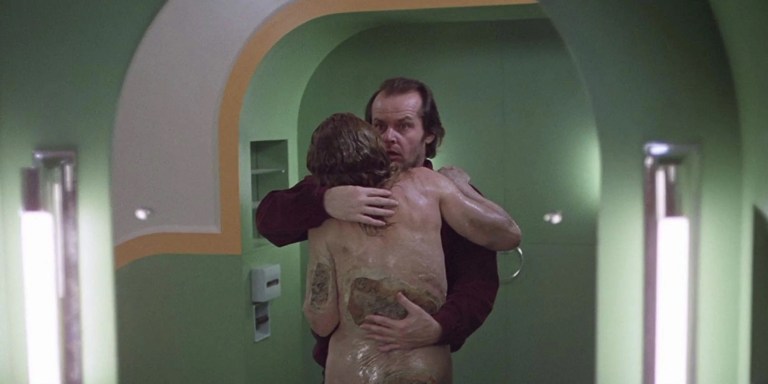
33. Nine hundred tons of salt and “crushed styrofoam” were used as snow.
34. At the time, blood was not allowed to be shown in movie trailers per the MPAA. Kubrick told them the elevator scene was rusty water in order to get it approved.
35. Kubrick terrorized Shelley Duvall on set, saying it was to get her to perform Wendy as a “humiliated and terrorized” woman. He isolated her from the other cast and crew, berated her publicly, and had her perform “the bat scene” 127 times. Duvall’s hair fell out in clumps during filming and she may have gotten PTSD she never recovered from.
36. Shelley Duvall kept bottles of water around her at all times while filming because she was dehydrated and “out of tears” from crying so much on camera.
37. Scatman Crothers was also reduced to tears on set by Kubrick’s management style.
38. Jack Nicholson’s girlfriend at the time, Anjelica Huston, said he would come home from work and immediately go to bed exhausted.
39. Nicholson ate only cheese sandwiches (which he hates) for weeks to get in the right angry mood for the role.
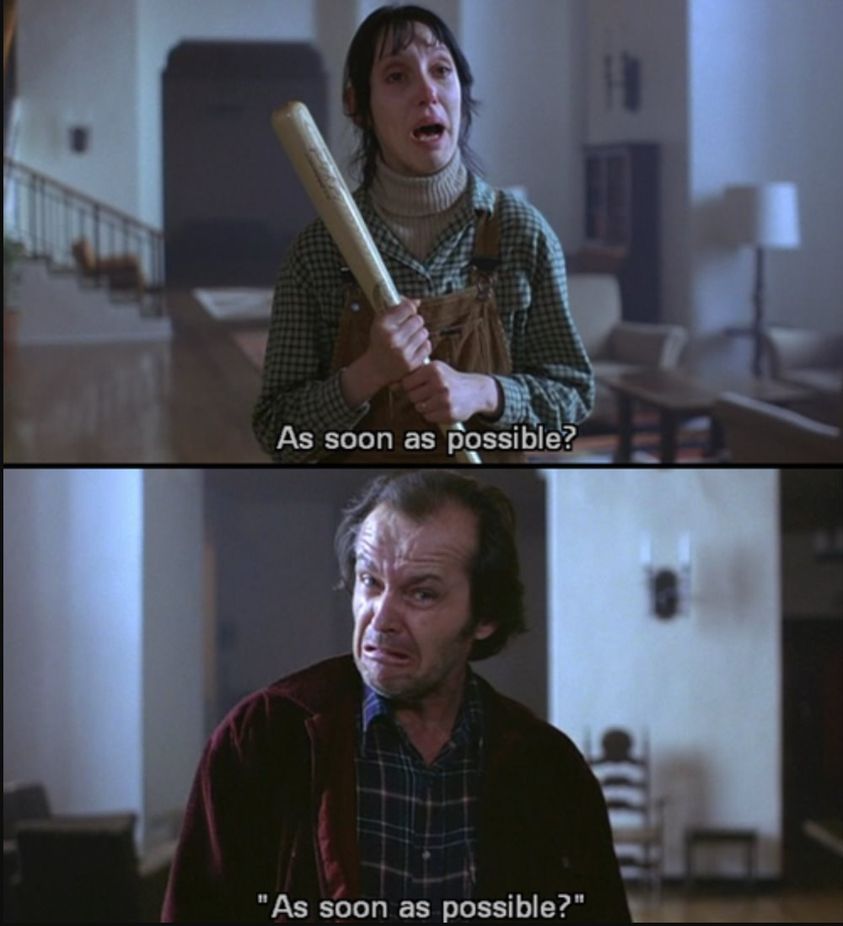
40. The script was rewritten so many times, Nicholson stopped reading it and learned his lines right before filming them.
41. Kubrick’s perfectionism extended to what other filmmakers might consider minutiae, like the writing Jack Torrance was doing on his typewriter. Kubrick had his assistant spend weeks typing the pages rather than photocopying them so that the pages would have slight errors and be more realistic. Kubrick also filmed different typed sentences for other languages the film would be released in. In German, Jack’s manuscript read, “Was du heute kannst besorgen, das verschiebe nicht auf morgen” which means “Never put off till tomorrow what may be done today”. In Italian it read “Il mattino ha l’oro in bocca” which means “The morning has gold in its mouth.” And in Spanish: “No por mucho madrugar amanece más temprano,” which means, “No matter how early you get up, you can’t make the sun rise any sooner.”
42. Jack Nicholson drew on his real-life experience as an aspiring writer who hated being interrupted for the scene where he flips out when Wendy brings him lunch.
43. Crew did 50 takes of the scene where the tennis ball rolls to Danny to get it the way Kubrick envisioned.
44. Vivian Kubrick, who was 17 at the time, made a 33-minute documentary called Making The Shining.
45. The Shining opened the same weekend as The Empire Strikes Back.

46. One week after the film had a mass-market release, Kubrick decided to cut out a scene at the end of the film where Wendy and Danny Torrance are in a hospital and are told by Mr. Ullman that police were unable to find Jack’s body. Of the change, Roger Ebert said, “Kubrick was wise to remove that epilogue. It pulled one rug too many out from under the story. At some level, it is necessary for us to believe the three members of the Torrance family are actually residents in the hotel during that winter, whatever happens or whatever they think happens.” However, Shelley Duvall disagreed and thought the scene was important and “Hitchcockian”: “I think he was wrong, because the scene explains some things that are obscure for the public, like the importance of the yellow ball and the role of the hotel manager in the plot. Wendy is in the hospital with her son. The manager visits her, apologizes for what happened, and invites her to live with him. She doesn’t say yes or no. Then he goes into the hallway of the hospital and passes in front of Danny, who is playing on the ground with some toys. When he gets near the exit, he stops and says, ‘I almost forgot, I have something for you.’ And he pulls from his pocket the yellow ball that the twins had thrown at Danny. It bounces twice (we spent a whole day filming so it would bounce the right way), Danny catches it, looks at it, then lifts his eyes toward the hotel manager, stupefied, realizing that throughout the story he was aware of the mystery of the hotel. There was a Hitchcockian side to this resolution, and you know that Kubrick was crazy about Hitchcock.”
47. Initial critical reviews of The Shining weren’t enthusiastic with Gene Siskel giving it two stars and others complaining that the film was too slow. The Shining was nominated for two Razzie awards for Worst Director and Worst Actress (for Shelley Duvall). When time, commercial success, and popular opinion changed the legacy of The Shining into a work of art, Nicholson and Duvall were upset that Kubrick was given all the credit for creating such a good film. Nicholson said that Duvall did “the toughest job of any actor that I’ve seen had.”
48. Of Kubrick’s interpretation of the character of Wendy Torrance, Stephen King said she is “basically just there to scream and be stupid, and that’s not the woman that I wrote about.”
King is, essentially, a novelist of morality. The decisions his characters make – whether it’s to confront a pack of vampires or to break 10 years of sobriety – are what matter to him. But in Kubrick’s The Shining, the characters are largely in the grip of forces beyond their control. It’s a film in which domestic violence occurs, while King’s novel is about domestic violence as a choice certain men make when they refuse to abandon a delusional, defensive entitlement. As King sees it, Kubrick treats his characters like “insects” because the director doesn’t really consider them capable of shaping their own fates. Everything they do is subordinate to an overweening, irresistible force, which is Kubrick’s highly developed aesthetic; they are its slaves. In King’s The Shining, the monster is Jack. In Kubrick’s, the monster is Kubrick.
Laura Miller, What Stanley Kubrick Got Wrong About ‘The Shining’
Trivia facts about Doctor Sleep (2013 novel)
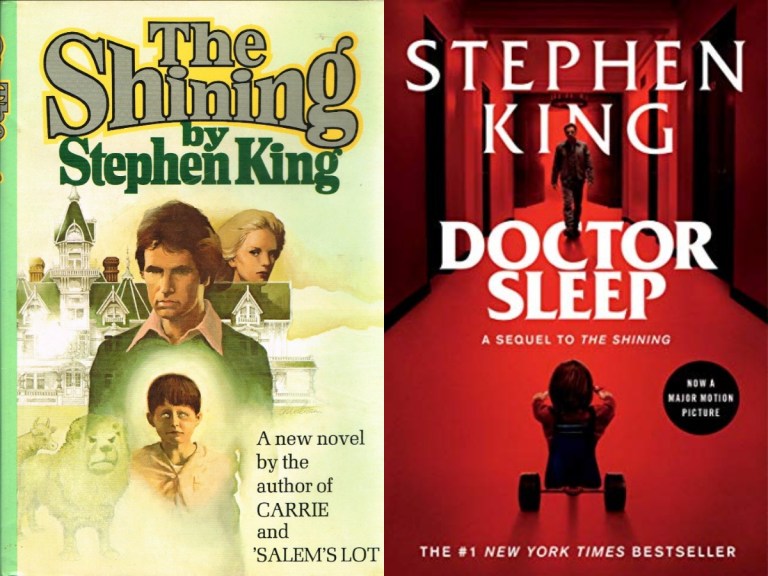
Doctor Sleep picks up shortly after the events of The Shining, with Wendy and Danny living in Florida and recovering from their traumatizing stay at the Overlook Hotel. Danny is plagued by visions of the ghostly spirits that haunted the hotel even though he is hundreds of miles away. Dick Hallorann is able to visit Danny via “the shine” and teach him how to lock the malevolent spirits away in lockboxes inside his head.
As an adult, Danny is an alcoholic who is successfully able to repress both the spirits and his feelings with alcohol. After an upsetting incident in which Danny wakes up from a blackout next to the passed-out mother of a neglected infant, he travels to New Hampshire and finds work and lodging with the help of a friendly stranger, Billy Freeman, who also helps Danny get into AA. At Danny’s job at a hospice, he is given the name “Doctor Sleep” because he uses his shine to help people transition peacefully out of this life and into whatever is next.
It is in this early stage of recovery that Danny psychically meets Abra Stone, a little girl with a shine even more powerful than his own. The two become aware that a group of vampire-like people called the True Knot are hunting for Abra, hoping to torture her in order to harvest her “steam” — their word for her psychic ability. Danny and Abra lead the True Knot back to the remains of the Overlook Hotel for an epic showdown of psychic power.
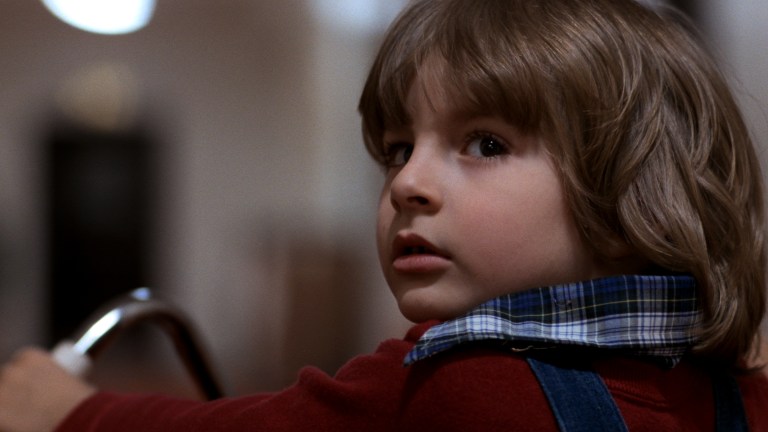
49. Of writing a sequel to such a famously scary (and commercially successful) story, King said, “The fear is that people will come back expecting that kind of scare as grown-ups and that just never happens. I wanted to try and write a more adult book.”
50. Of the difference between his critical reception around the time he wrote The Shining (1977) and Doctor Sleep (2013), King said, “Little by little the wind changed a little bit. I think a lot of what happened was, that a lot of the old timers, the critics who really greeted my work with disdain died off and the people who are critics now, I know I scared the hell out of them when they were kids and they kind of respect that.”
Trivia Facts about Doctor Sleep (2019) dir. Mike Flanagan
51. Well aware of the discord between artists Stephen King and Stanley Kubrick, director Mike Flanagan set out to please horror fans by creating a sequel that would be as faithful as possible to both the novel and Kubrick’s film. Of his decision, Flanagan said, “The Shining is so ubiquitous and has burned itself into the collective imagination of people who love cinema in a way that so few movies have. There’s no other language to tell that story in. If you say ‘Overlook Hotel,’ I see something. It lives right up in my brain because of Stanley Kubrick. You can’t pretend that isn’t the case.”
52. Flanagan used blueprints from Stanley Kubrick’s estate to recreate scenes at the Overlook in painstaking detail. A good example of this work is that Dr. John Dalton’s office is almost identical to Stuart Ullman’s office where Jack Torrance was interviewed for the caretaker position.
53. When Stephen King read Mike Flanagan’s script, he said, “Everything that I ever disliked about the Kubrick version of The Shining is redeemed for me here.”
54. As an atheist, Kubrick didn’t want to tell a ghost story. He didn’t believe in ghosts or in any kind of afterlife at all. A major plot point in King’s sequel, Doctor Sleep, would be Danny Torrance’s understanding that “We go on.”
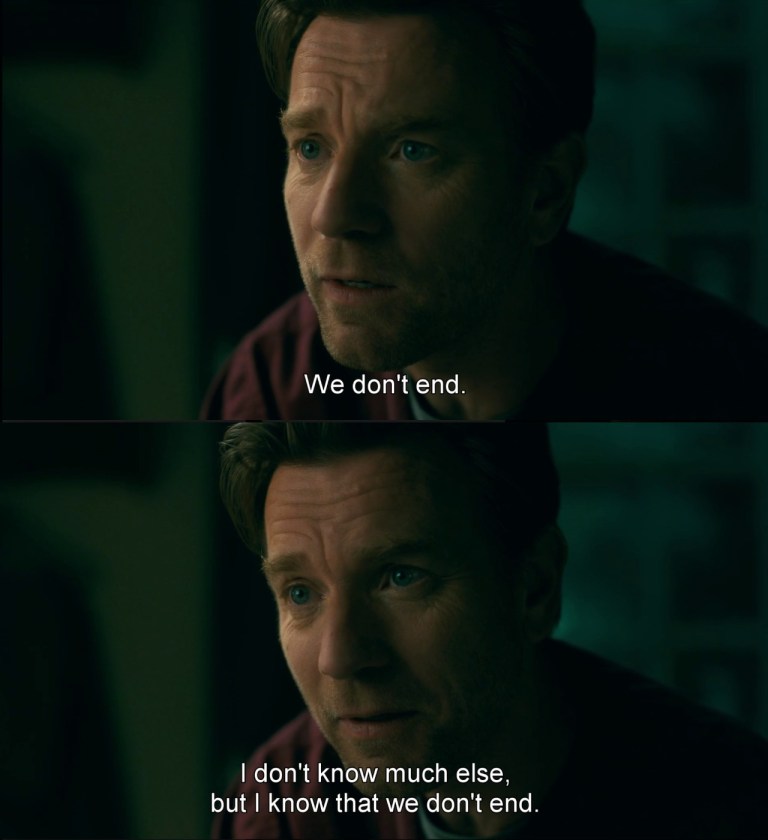
55. This is a theme King has written about in many of his books, including Pet Sematary. Here’s a still from the 1989 adaptation:
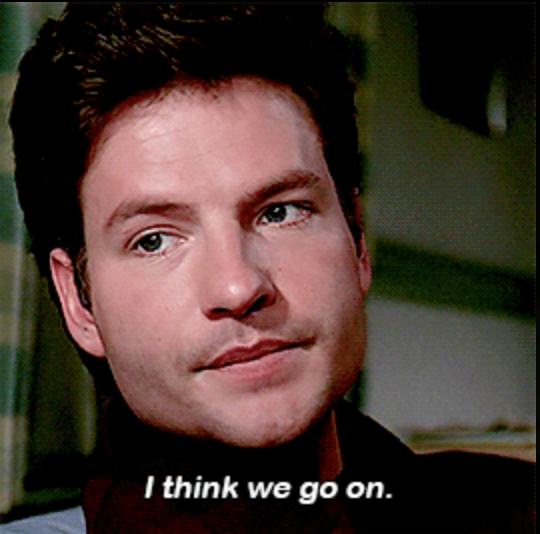
56. Three aerial shots from Kubrick’s original opening scene were used in Doctor Sleep. Flanagan digitally added snow.
57. While at work at the hospice, Danny is seen reading the January 1978 issue of Playgirl Magazine. This is the same magazine his father was reading in the lobby of the Overlook before his job interview.
58. Before he wrote Doctor Sleep, Stephen King used to joke that Danny Torrance grew up and married Charlene McGee from Firestarter (1984). If Doctor Sleep and Firestarter exist in the same universe, Charlene would have also been hunted down by the True Knot.
59. Dick Halloran tells Danny, “Ka is a wheel, Doc.” This is mythology from King’s Dark Tower series. It means that a person will continue to be brought to a place in life where they will face their destiny again and again until their lesson is learned.
60. Azzie, the hospice cat that predicts when a patient is going to die, is based on the real story of Oscar (RIP), a tabby who was said to predict the deaths of patients at Steere House Nursing and Rehabilitation Center in Rhode Island.
